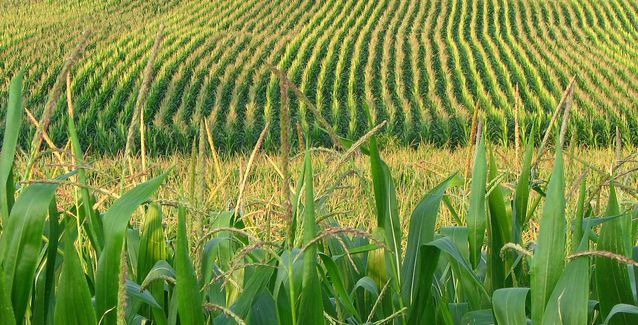Corn has near banner year; winter wheat prices approach 10-year high
by January 6, 2022 12:08 pm 939 views

Maize, or corn, is one of the oldest domesticated crops in human history. It was first grown in southern Mexico more than 10,000 years ago. No one knows when the grain first made its way to Arkansas, but Spanish explorers reported vast fields of corn when they explored the state’s Delta region in the early 1540s.
From that time on, it’s been a staple crop in the Natural State.
Severe flooding early in the planting season threatened the crop, but farmers were able to rally and produced a banner year of corn with a state average of 183 bushels per acre.
Prompted by attractive market prices, Arkansas farmers also increased grain sorghum production and are on course to increase winter wheat acreage. Grain sorghum production rose to 90,000 acres, which was a marked increase from the 12,000 acres planted in 2020. Although down one bushel per acre from 2020, the 183 bushels per acre Arkansas average in 2021 was higher than this year’s U.S. record high average corn yield of 177 bushels per acre.
The state average record corn yield was 187 bushels per acre in 2014. Arkansas farmers planted 850,000 acres of corn, a 37% increase as compared to 2020 when compared to 620,000 acres grown the previous year. It’s the second highest number of acres of corn planted since 1954.
Nationally, corn acreage increased only slightly from about 90.9 million acres to about 92.7 million acres. The U.S. is the top corn producing country, harvesting about 400 million metric tons each fall, according to the United States Department of Agriculture (USDA).
“There are several reasons for the increase in acreage, but a relatively good planting window in March and April and prospects for a good grain price were the driving factors,” said Jason Kelley, University of Arkansas System Division of Agriculture professor and wheat and feed grains extension agronomist.
Nearly all farms in southern Arkansas were impacted to some degree by the early June storms and flooding, Kelley said. Flooding, wind damage and nitrogen loss from saturated soils all contributed to loss in yield.
“If it had not been for the early June storms and flood, the state was on track for a record yield,” Kelley said. “But 183 bushels per acre is still a great yield. A good harvest window with no direct hit from tropical storms really helped harvest progress along without issues.”
Fertilizer prices are projected to double and, in some cases, triple the price during the upcoming growing season and it could have an impact on producer’s plans to grow corn.
“Currently, fertilizer prices and input costs have corn and other crop farmers struggling to pencil out plans for 2022,” Kelley said. “Fertilizer prices now are currently double or more what they were in 2021.”
Increasing fuel costs, labor shortages and limited availability of other inputs such as herbicides and fungicides are issues Arkansas farmers will face 2022.
A bright spot, for corn growers at least, is that tar spot has not been identified in Arkansas, Kelley said. The disease caused by the fungus Phyllachora maydis was first detected in northern Indiana and Illinois in 2015, according to the USDA Agricultural Research Service. Tar spot can reduce grain yields by 20 to 60 bushels an acre and has been identified in corn-growing areas of Iowa, Michigan, Minnesota, Missouri, Ohio, Pennsylvania, Wisconsin, Florida, and southwestern Ontario, Canada, the USDA noted. Kelley said tar spot has also been spotted in Georgia, Illinois and Kentucky.
The 650% increase in grain sorghum acres were planted primarily in counties surrounding Helena and West Memphis, Kelley noted. The grain is primarily used in animal feed and by a growing number of ethanol plants, but grain sorghum is gaining popularity in the U.S. because of its gluten-free property and because it is celiac safe, according to National Sorghum Producers.
China has been the largest buyer of American-produced grain sorghum over the last few years and has helped provide price support for the crop, Kelley said.
“Summer rains were nearly ideal, and yields were good to excellent for most sorghum farmers,” Kelley said of the Arkansas grain sorghum crop.
Sugarcane aphid is still a concern for grain sorghum in Arkansas, but Kelley said producers have learned how to manage the pest through close scouting and planting sugarcane aphid-tolerant hybrids.
With prices near a 10-year high, Arkansas growers likely increased the number of acres planted, Kelley said. There were about 210,000 acres of winter wheat planted in the state last year. The USDA’s National Agricultural Statistics Service (NASS) agricultural wheat planting report is expected in January.
“Overall, we have had a good fall for planting wheat and the warm weather in December has allowed the crop to obtain good growth this fall,” Kelley said.
By early December, wheat was trading at just over $8 a bushel following a steady increase this fall. The season-average farm price for wheat rose 20-cents per bushel to $6.90 in the fall based on strong prices reported in the Oct. 29 NASS Agricultural Prices report. The September 2021 all-wheat price was estimated at $7.55, which was up from $7.13 in August 2021 and about 60% above the $4.73 in September 2020, according to the USDA’s Economic Research Service.
